India on Three Wheels
India
It had just topped 45�C, the sun was blazing high above us in a clear blue sky and a hot wind was blowing across the cracked dry plain, drying out my eyeballs so I could barely see the potholes in the road as I drove. My kidneys felt bruised from the constant pounding of the rickshaw and my back, as well as the rest of my body, were aching nearly as much. We were somewhere out in the middle of the desolate Uttar Pradesh countryside, nearly out of gas, with only a liter of water between us and we had not seen a village, mud hut or another individual for miles. It was times like those that I wondered how I had gotten myself involved in such an adventure.
Ever since leaving India our first time there, my two brothers and I had promised each other that one day we would return to the county and do something special. As time wore on however, and we began to go our separate ways we collectively felt our promise slipping away. Then came the inspiration we were waiting for. It was sudden and was provoked by nothing more than daydreaming, but it was just what we had been waiting for.
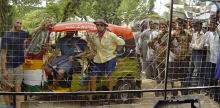

With the Rickshaw
![]()
![]() We chose the auto rickshaw because it’s the workhorse of the nation, the vehicle that every man, woman and child in India can relate to. We knew its wheels were closer to the ground then the wheels of a bus or the rims of a railcar, and it would allow us to easily stop anywhere at anytime. Without doors, shocks, trunk, or any great engine power, the rickshaw provided the most basic and oddly funky, yet horrendously uncomfortable form of transportation possible. And after a personalized paint job and solid name, ‘Kopidwag,’ the great warrior Arjuna’s chariot driven by Lord Shiva in the Indian epic the Bhagavad Gita, our oddball crew would become the sideshow of the nation.
We chose the auto rickshaw because it’s the workhorse of the nation, the vehicle that every man, woman and child in India can relate to. We knew its wheels were closer to the ground then the wheels of a bus or the rims of a railcar, and it would allow us to easily stop anywhere at anytime. Without doors, shocks, trunk, or any great engine power, the rickshaw provided the most basic and oddly funky, yet horrendously uncomfortable form of transportation possible. And after a personalized paint job and solid name, ‘Kopidwag,’ the great warrior Arjuna’s chariot driven by Lord Shiva in the Indian epic the Bhagavad Gita, our oddball crew would become the sideshow of the nation.
Kipling once said, ‘You don’t take the Grand Trunk Road, it takes you.’ That is exactly what happened when my two brothers and I began to do what had never been done before, self-drive an auto rickshaw border to border across the entire historic Grand Trunk Road of India.
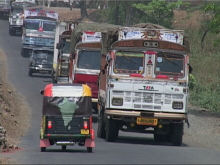

Rickshaw on the road
![]()
![]()
![]()
![]() I will say again that the journey had never been done before, but simply because it was a stupid one. The trip would be incredibly uncomfortable, time consuming, difficult and above all, suicidal. Indian roads are lawless. They are a scary limbo of bad roads, few rules, and worn out vehicles. To drive across India in a big, sturdy vehicle is dangerous enough; to drive across India in a dinky one is ridiculous. This explains why when we landed in the Bengali capitol of Kolkatta we were received with skepticism, disbelief and awe.
I will say again that the journey had never been done before, but simply because it was a stupid one. The trip would be incredibly uncomfortable, time consuming, difficult and above all, suicidal. Indian roads are lawless. They are a scary limbo of bad roads, few rules, and worn out vehicles. To drive across India in a big, sturdy vehicle is dangerous enough; to drive across India in a dinky one is ridiculous. This explains why when we landed in the Bengali capitol of Kolkatta we were received with skepticism, disbelief and awe.
Kolkatta, formerly Calcutta and the world’s stronghold of the dying and destitute, is now a somewhat revitalized city of friendly, welcoming Indians. We landed in March, summer was quickly approaching and the heat and humidity were already becoming uncomfortable; over the course of the trip heat was to become one of our worst nemeses making us constantly regret our choice in timing. The weather and the startling human condition of the country immediately made us second-guess our entire idea. The snarling traffic, choking pollution, beggars, street kids, disease, noise and filth were shocking. Though somehow, somewhere under all the struggle and pain we could feel a sense of hope and strength and cheerfulness radiating from all the confusion. We realized from the beginning that India was still a very rare and special place.
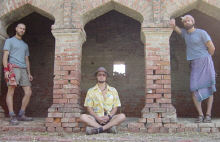

The Fearless Trio
![]()
![]() The first month we never even got near the road. It was miles of red tape, mountains of paperwork and endless hassles in the crowded hallways and busy offices of the West Bengal government buildings. Rickshaws are commercial vehicles. They are short haul taxis and mini-uhauls only registered to certain specific areas. Getting permission to buy one and drive it across the country was a slow, frustrating process. Still, Indians themselves love saying, ‘Why not?’ and ‘In India anything is possible!’ so with our wild idea and our unbending belief in our mission we soon found the Indians willing to do anything to help us reach our goal.
The first month we never even got near the road. It was miles of red tape, mountains of paperwork and endless hassles in the crowded hallways and busy offices of the West Bengal government buildings. Rickshaws are commercial vehicles. They are short haul taxis and mini-uhauls only registered to certain specific areas. Getting permission to buy one and drive it across the country was a slow, frustrating process. Still, Indians themselves love saying, ‘Why not?’ and ‘In India anything is possible!’ so with our wild idea and our unbending belief in our mission we soon found the Indians willing to do anything to help us reach our goal.
After a month of beauracratic run-around and a million ‘why’s’ and ‘how’s’ and ‘surely not’s!’ we eventually obtained the final piece of special permission we needed from the transport minister, and purchased our rickshaw. On April 1st, ‘Fool’s Day,’ after an anxious sleep and an exciting press conference full of disbelieving reporters, we set out from ‘Mile 0’ of the Grand Trunk Road in Kolkatta. Our long struggle towards the Pakistan Border on the opposite end of the country had begun. The Grand Trunk Road, a vestige of the old silk road commissioned by the Moghal King Sher Shah Suri, and its winding, rugged path across seven states of northern India; West Bengal, Bihar, Jarkhand, Uttar Pradesh, Delhi, Haryana, and Punjab, had become a reality.
With thousands of miles to cross, the world’s largest democratic election starting up, and Indian summer just around the corner, we had additional obstacles to worry about other than language problems, cultural differences, bandits, disease, poverty, and catatonic roads full of suicidal drivers. Over the course of the trip we would learn much about patience and self-belief. In a country where western priorities loose shape, and money and possessions take on a new meaning, where time takes on another form and ideas and emotions sprout like flowers in a monsoon rain, my brothers and I were to be changed forever.
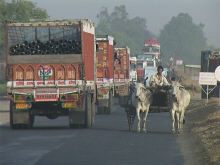

The Real Road
![]()
![]()
![]()
![]() That first day and those initial few miles on the road will stick in my mind forever. I had just read Kipling’s book Kim and had a very romantic image of the Grand Trunk Road; a wide, tree lined thorough-fare full of happy locals and meandering traffic, with green fields stretching off to both sides. These images however, were quickly obliterated from my mind that first morning. Pinned onto a narrow road by two encroaching rows of shops the ‘highway’ was a thin, pot-holed strip of tarmac crammed with all means of traffic, human and animal, everyone weaving and fighting their way forward. Fear was the most predominant emotion I felt that first day, fear and disbelief. My brothers and I banded together though struggling for our own bit of space in the ensuing madness and steered our rickshaw bravely forward.
That first day and those initial few miles on the road will stick in my mind forever. I had just read Kipling’s book Kim and had a very romantic image of the Grand Trunk Road; a wide, tree lined thorough-fare full of happy locals and meandering traffic, with green fields stretching off to both sides. These images however, were quickly obliterated from my mind that first morning. Pinned onto a narrow road by two encroaching rows of shops the ‘highway’ was a thin, pot-holed strip of tarmac crammed with all means of traffic, human and animal, everyone weaving and fighting their way forward. Fear was the most predominant emotion I felt that first day, fear and disbelief. My brothers and I banded together though struggling for our own bit of space in the ensuing madness and steered our rickshaw bravely forward.
My brother Chris put it best that first day when he said, “This trip is going to be like eating an Indian curry. We have no idea what will come out the other end.”
As we became familiar with how to drive the rickshaw and the chaos of the roads, the trip quickly got better. The people proved to be a constant pleasure throughout the trip, changing looks, language and customs as we made our way across the country but never changing in hospitality, curiosity or courtesy.
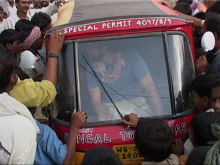

Crazy Crowds
![]()
![]()
![]()
![]() Everywhere along the trip we faced constant discomfort, chaos and beauty in varying degrees wherever we found ourselves. At times the crowds around the rickshaw were so thick that it became almost scary, illiterate locals jostling for a look at the three foreigners in a painted rickshaw. We ran out of gas and slept on string beds at roadside truck stops where we were plagued by mosquitoes. We dealt with shifty police and dodgy shop-keepers, got bouts of wretched diarrhea, sunstroke, heat rash, exhaustion, homesickness, and were scared out of our wits end by all the near misses we had on the road. Caravans of speeding trucks and reckless buses roared past our little rickshaw making us feel helpless, like a mouse amongst lions. It only reconfirmed the adage of Indian roads though, where ‘might is right’ and where rupees rule the road. In a land of a billion plus people we found that the curious mobs were going to become an enduring test of patience. From their viewpoint though, three white guys in a rickshaw, I’d stare too. Yet through all of the crowds, discomfort, and fear the country and the kindness of its people continued to shine through radiantly.
Everywhere along the trip we faced constant discomfort, chaos and beauty in varying degrees wherever we found ourselves. At times the crowds around the rickshaw were so thick that it became almost scary, illiterate locals jostling for a look at the three foreigners in a painted rickshaw. We ran out of gas and slept on string beds at roadside truck stops where we were plagued by mosquitoes. We dealt with shifty police and dodgy shop-keepers, got bouts of wretched diarrhea, sunstroke, heat rash, exhaustion, homesickness, and were scared out of our wits end by all the near misses we had on the road. Caravans of speeding trucks and reckless buses roared past our little rickshaw making us feel helpless, like a mouse amongst lions. It only reconfirmed the adage of Indian roads though, where ‘might is right’ and where rupees rule the road. In a land of a billion plus people we found that the curious mobs were going to become an enduring test of patience. From their viewpoint though, three white guys in a rickshaw, I’d stare too. Yet through all of the crowds, discomfort, and fear the country and the kindness of its people continued to shine through radiantly.
What started out as a rollicking journey across an extraordinary country quickly turned into an astonishing religious pilgrimage into six of the world’s greatest faiths. Be it Hindu, Muslim, Sikh, Buddhist, Jain or Christian, with religion being the root of all things to all people in India, we quickly found ourselves staring into the face of thousands of years of history, belief, ritual and energy, and realized that great faith and life are synonymous in India, one of the world’s most enigmatic developing countries.
“I don’t know what will happen, but I know by the end of the trip that India will change me forever.” I said it and I meant it, and in the end it came true. India is reality, the good, the bad and the ugly of life. Pity her, fear her, love her, India is a wonder, relentless as the messages handed down over 5000 years in the holy Mahabarata. She is sweet as a Kerela mango and bitter as Bengali chutney. Like the course of war or pregnancy or a great illness, India on three wheels was the kind of wild experience that helps shape a man’s character. It reinforced the values I already believed in, bestowed new ones, and gave me an insight into the reality of the world before me, around me and after me. For more than a millennium wanderers, seers, pilgrims, and kings have traversed India in search of answers. Most of them came away mystified and enlightened by her beauty and power, and when we finally reached the Pakistan border after four months, 5000 kilometers and a spot in the Indian Book of Records, so had we.
Jeff, 32, Chris, 31, and Steve, 30, made this trip from April 1st to July 31st, 2004. The brothers have been traveling the globe together for the last 10 years. Though born in Canada, Jeff now resides in Japan, and Chris and Steve in England. This is the latest of their adventures and more stories and photos can be seen on their website – www.eagarbros.com. The site also contains a short video and photos of their Indian trip, proving that this little slice of insanity actually happened!